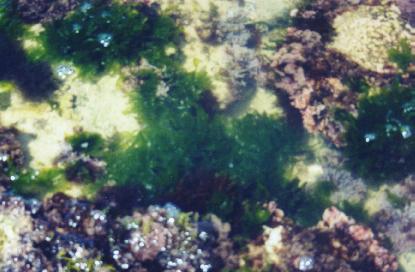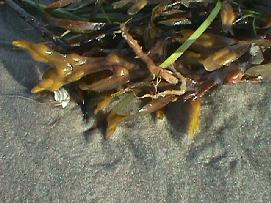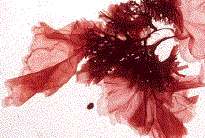
Members include seaweeds, sea grasses, mangroves, marsh grass, microscopic algae etc. If you don't include blue-green algae (prokaryotic)
While most are referred to as plants, some have flagella and show animal characteristics...and some are actually claimed by both botanists and zoologists as theirs! Taxonomically, a compromise has placed them in the Kingdom Protista..the unicellular forms.
Seaweeds...dominant marine plants containing chlorophyll and additional pigments from blue to red. Seaweeds (exc. noted) are all eukaryotic and most are multicellular but even some that are unicellular or simple filaments are considered seaweed because the classifications of seaweeds is based not only on structure, but also on other features such as types of pigments and food storage products.
Classification characteristics used to classify are;
Red Algae is Rhodophyta
Green Algae is Chlorophyta
Brown Algae is Phaeophyta
Algae are Thallus, meaning they lack true roots, stems, and leaves, fruits, connecting tissue etc. and photosynthesis occurs throughout the plant, not just the leaves.
Parts: Holdfast, stipe, blade, air bladders (pneumatophores). (list functions)
Brown Algae...Phaeophyta..microscopic to 60' make up the largest and structurally most complex. Colors range from olive green to dark brown, due to yellow pigments fucoxanthin dominance over chlorophyll. Pigments are xanthophyll and carotene and chlorophyll.
The simplest brown algae have a finely filamentous thallus as in Ectocarpus. There is the fan shaped Padina. Many species of brown algaes are found in the intertidal zone and known as rockweeds and in deeper areas of the cool coastal zones are the kelps, the largest and most complex of all brown algaes. As mentioned before, kelp plays an important i the coastal production with many organisms finding homes around the kelp beds. Some kelps consist of a single blade, Laminaria, which are harvested for food. Kelps have been estimated to grow up to 50 cm (20 inches) per day. Note these have the pneumatocysts.
Alginic Acid, a gummy, slimy layer in cell wall, is used as an emulsifying agent (algin)..(Know uses)
Red Algae..Rhodophyta has more species of these than green and brown combined. It has the highest commercial value, and don't get as large as brown algae.

Coralline Algae
The structure of the thallus of red algae does not show the wide variation in complexity and size that is observed in brown algae. Most reds are filamentous but thickness, width and arrangement of the filaments vary a great deal. There are many variations in the shapes, sizes colors etc. of the reds. One important in marine environments are the red alga Corallines. These are characterized by deposits of calcium carbonate around their cell walls. These can be encrusting on the rocks or articulated, branching plants, with colors from light to reddish pink-white when dead. Warm water corallines are active in reef development.
Green Algae CHLOROPHYTA. The great majority of green algae are restricted to fresh water and terrestrial environments. Only 10% are marine but they are dominant in environments with wide variations in salinity such as bays and estuaries, tide pools (sewage outfalls) . ..stock from which land plants derived and in full agreement in regards to pigment, starch, cellulose etc. May exist as single cells, simple or branched filaments, blades, organized into tubes that are intertwined and usually grass green in color.
Few green algae are as complex as the other groups but their pigments and food reserve are the same as in higher plants. (evolved from green algae.) chlorophyll b in green and land but not other algaes). They are unicellular, filamentous multicellular, shapes can vary in the same species according to their environment. Enteromorpha is a thin hollow tube, Ulva, sea lettuce is leafy-like, Valonia, forms huge spheres /clusters of them in tropical waters., some branch and Caulerpa and Cladophora have tubes with many nuclei, spongy, branching thallus Codium and segmented with deposits of calcium carbonate in their walls to ward off predators but end up cementing the reef together in reef areas...Halimeda... a Coralline green algae!
Life Histories of seaweeds involve an alternation of gamete producing phase (gametophyte) and spore producing phase (sporophyte). (Video of Gamete release)
 Green algae...Ulva
(sea lettuce) have two identical phases. 1. Sporophyte
(diploid) produces flagellated zoo spores (haploid) (meiosis) and
these 2. swim briefly and settle on the bottom and 3. grow into a
gametophyte phase (male or female) and produce motile gametes
which 4. fuse to form zygotes (diploid). ....Codium,
another green algae is more like animals and produces gametes by
meiosis which fuse and form a zygote and grows into the familiar
plant.
Green algae...Ulva
(sea lettuce) have two identical phases. 1. Sporophyte
(diploid) produces flagellated zoo spores (haploid) (meiosis) and
these 2. swim briefly and settle on the bottom and 3. grow into a
gametophyte phase (male or female) and produce motile gametes
which 4. fuse to form zygotes (diploid). ....Codium,
another green algae is more like animals and produces gametes by
meiosis which fuse and form a zygote and grows into the familiar
plant.
Brown algae...Nereocystis (bull kelp). The kelp is the sporophyte or diploid phase and

Kelp (how are chances for fertilization increased?) ....Fucus,
another brown algae or rockweed, is again, like animals where the

Gametes are produced in cavities called CONCEPTACLES.
Red algae Porphyra or nori is a valuable food source
but has an atypical life history with the gametophyte being the
large leafy plant and the sporophyte being the tiny
"conchocelis" found living in discarded shells. The Typical red cycle is
that of Polysiphonia.
The Typical red cycle is
that of Polysiphonia.
Marine Angiosperms (flowering plants)...few occur in the marine environment but those that do are usually very productive and adapted for their lifestyle. Of the 3 groups, mangroves, marsh grass and seagrass, only the sea grasses are adapted to live completely submerged in water. Pollination occurs under water.
Seagrasses are not grasses, and thrie closest relatives are probably lilies. Pollen is carried by water currents and seeds are dispersed by water currents and feces of fish and other animals that browse of the plants. Eel Grass (Zostera) is the most widely distributed of the 50 species and found in shallow, well-protected coastal waters such as bays and estuaries. It has distinct flat ribbon like leaves. Surf grass (Phyllospadix) is on rocky coasts exposed to waver action. Turtle grass (Thalassia) is common in the keys. ( Manatee Grass (Halophila)).
Mangroves..80 unrelated species of flowering plants adapted to various ways to survive in the salty environment. Mangroves have a special root system using aerial roots to ventilate the system below the substratum (especially in anaerobic mud and under water). Some genera have seeds that germinate on the parent plant and drop as seedlings rather than seeds.
Saltmarsh plants, true members of the grass family, usually consists of succulent shrubs and herbs and grass-like species which can tolerate large salinity fluctuations. Cord grass inhabits the zone above the mud flats and can be submerged, and have salt glands to get rid of excess salt. Halophytes are found in higher levels of the marsh (pickleweed).
Phytoplankton...plankton..Greek for wanderer meaning that they are passively transported. Nekton are those that swim. Size categories of plankton:
Types:
Divisions
Division Cyanophyta/Cyanobacteria Blue green Algae are prokaryotic cells specialized to carry on photosynthesis. Chlorophyll, phycobilins, phycocyanin, beta-carotene and xanthophylls are the pigments so color range is great..red, blue-green, black, olive, yellow, violet. The only other prokaryotes that carry out photosynthesis are some Autotrophic bacteria. There are hemosynthetic bacteria too that release stored energy in chemical compounds (H2S) . Blue-green algae contain a bluish pigment, PHYCOCYANIN. (Considered bacteria). Photosynthesis occurs on folded membranes within the cell (rather than chloroplasts). They do produce O2 etc. and probably played a role in the oxygen in the atmosphere. The presence of this ultraplankton is only being discovered .
Responsibilities of blue greens include forming dark crusts along wave splashed zones , exploiting polluted sediments and even forming a few types of red tides (Trichodesmium erythraea).(skin rashes). Blue-greens also carry out nitrogen fixation in the oceanm, converting N into nitrates to be converted to proteins. Some blue-greens live on the surfaces of seaweeds and sea grasses (epiphites) and some are known to lose their ability to photosynthesize, becoming heterotrophs.
Chlorophyta..few marine planktonic reps. but lots of macroscopic, benthic types
. Chrysophyta...golden/yellow color because in addition to chlorophyll. a & c there is a dominant carotenoid, fucoxanthin and many members have a cell covering of small siliceous scales. The silicoflagellates have an internal glass skeleton. Rare today.Characterized by star shaped internal skeleton made of silica and a single flagellum.
Haptophyta.. or Coccolithophorids, flagellated spheric cells covered with button like structures called coccoliths made of calcium carbonate. This was broken off the above class because of different types of flagella. Phaeocystis forms gelatinous clumps, visible and can effect migration patterns of fish. Also, blooms long ago followed by anaerobiosis, caused them to sediment and gave rise to oil deposits in the North Sea. The coccolithophores have small calcareous plates covering them and the patterns go way back in fossil records and are used by oil companies.
Xanthophyta...like Chrysophyceae but have no fucoxanthin pigment.
Euglenophyta...euglena..class contains only unicellular flagellates, chlorophyll. A and B and a flexible cell covering...no wall!
Fungi There are at least 500 species of marine fungi, most which are decomposers of dead organic matter. Some are parasites causing diseases in fish , shellfish, seaweed and sponges. Also some form associations with algae forming lichens and marine lichens may be found as thick, dark-brown/black or even orange patches on the wave splashed zones on rocky shores.
Bacillariophyta...diatoms...most important group in terms of primary productivity. The characteristic yellow-brown color is due to CAROTENOID pigments in addition to two types of chlorophyll (a and c). Half of the 12,000 species are marine. The brownish scum in a fish tank consists of millions of diatoms.
Diatom Characteristics
Reproduction...valve to valve...one product of the division retains the parental epivalve (top) and the other the parental hypovalve (bottom) which results in the bottom being slightly smaller than the parent because a new inside always grows back. Continued vegetative reproduction reduces the size until it gets to its smallest size and this diploid cell produces gametes which fuse to form a full size zygote. Only the small cells will undergo sexual reproduction and if they get too small, they can't even do that.
Dinophyta /Pyrrhophyta or the Dinoflagellates Mostly unicellular with 2 unequal flagella , one that wraps around a groove in the middle of the cell, and the other that trails free, and include the non-motile zooxanthellae (found in corals). The are most abundant in warm waters and second to diatoms in cold water.
Characteristics of Dinoflagellates
The Zooxanthellae are a variety of dinoflagellates which have developed a close association with an animal host. The hosts range from sponges to giant clams but the most important are the ones in the stony corals. They help fix carbon through photosynthesis, release organic matter to be used by the coral, help in formation of the coral skeleton.
THE IMPORTANCE OF CORALLINE ALGAE
Corallines as carbon stores
Coralline algae take up carbon for use in the process of photosynthesis, as do most plants, but they have an additional mechanism of carbon uptake, the calcification process. Calcium is deposited in the cell walls of coralline algae in the form of calcium carbonate. One of the most exciting pieces of information which I have recently received came from a Brazilian marine biologist, E.C. de Oliveira, who has presented evidence that coralline algae may be one of the largest stores of carbon in the biosphere. If this is so, then they urgently need to be studied, since we know so little about even their basic ecology, particularly in the Indo-Pacific region.
Corallines in community ecology Many corallines produce chemicals which promote the settlement of the larvae of certain herbivorous invertebrates, particularly abalone. This is adaptive for the corallines as the herbivores then remove epiphytes which might otherwise smother the crusts and pre-empt available light. This is also important for abalone aquaculture, as corallines appear to enhance larval metamorphosis and the survival of larvae through the critical settlement period. It also has significance at the community level, as the presence of herbivores associated with corallines can generate patchiness in the survival of young stages of dominant seaweeds. I have seen this in eastern Canada, and I suspect the same phenomenon occurs on Indo-Pacific coral reefs, yet nothing is known about the herbivore enhancement role of Indo-Pacific corallines, or whether this phenomenon is important in our coral reef communities.
Some corallines slough off a surface layer of epithallial cells, which in a few cases may be an anti-fouling mechanism which serves the same function as enhancing herbivore recruitment. This also affects the community, as many algae recruit on the surface of a sloughing coralline, and are then lost with the surface layer of cells. This can also generate patchiness within the community. The common Indo-Pacific corallines Neogoniolithon sp. and Sporolithon ptychoides slough epithallial cells in continuous sheets which often lie on the surface of the plants looking so much like wet tissue paper. Not all sloughing serves an anti-fouling function. Epithallial shedding in most corallines is probably simply a means of getting rid of damaged cells whose metabolic function has become impaired. Sloughing in the South African intertidal coralline algae, Spongites yendoi, was studied and it was found it sloughs up to 50% of its thickness twice a year. This deep-layer sloughing, which is energetically costly, does not have any effect on seaweed recruitment when herbivores are removed. The surface of these plants is usually kept clean by herbivores, particularly the pear limpet, Patella cochlear. Sloughing in this case is probably a means of getting rid of old reproductive structures and grazer-damaged surface cells, and reducing the likelihood of surface penetration by burrowing organisms.
Some coralline algae develop into thick crusts which provide microhabitat for many invertebrates. For example, off eastern Canada, ,juvenile sea urchins, chitons, and limpets suffer nearly 100% mortality due to fish predation unless they are protected by knobby and under-cut coralline algae. This is probably an important factor affecting the distribution and grazing effects of herbivores within marine communities. Nothing is known about the microhabitat role of Indo-Pacific corallines. However, the most common species in the region, Hydrolithon onkodes, often forms an intimate relationship with the chiton Cryptoplax larvaeformis. The chiton lives in burrows that it makes in H. onkodes plants, and comes out at night to graze on the surface of the coralline. This combination of grazing and burrowing results in a peculiar growth form (called castles) in H. onkodes in which the coralline produces nearly vertical, irregularly curved lamellae.
Non-geniculate corallines are of particular significance in the ecology of coral reefs, where they provide calcareous material to the structure of the reef, help cement the reef together, and are mportant sources of primary production. Coralline algae are especially important in reef construction, as they lay down calcium carbonate as calcite. Although they contribute considerable bulk to the calcium carbonate structure of coral reefs, their more important role in most areas of the reef, is in acting as the cement which binds the reef materials together into a solid and sturdy structure.
An area where corallines are particularly important in cobnstructing reef framework is in the algal ridge that characterizes surf-pounded reefs in both the Atlantic and Indo-Pacfic regions. Algal ridges are carbonate frameworks that are constructed mainly by nongeniculate coralline algae (after Adey 1978). They require high and persistent wave action to form, so are best developed on the windward reefs in areas where there is little or no seasonal change in wind direction. Algal ridges are one of the main reef structures that prevent oceanic waves from striking adjacent coastlines, and they thus help to prevent coastal erosion.
Economic importance
Despite their hard, calcified nature, coralline algae have a number of economic uses. One use dates back to the 18th century, and involves the collection of unattached corallines (maerl) for use as soil conditioners. This is particularly significant in Britain and France, where more 300 000 tonnes of Phymatolithon calcareum and Lithothamnion corallioides are dredged annually. Several thousand kilometres of maerl beds, composed of as-yet undetermined species belonging to the genera Lithothamnion and Lithophyllum, exist off the coast of Brazil, and have been subjected to a low level of commercial exploitation. Maerl is also used as a food additive for cattle and pigs, as well as in the filtration of acidic drinking water.
Corallines are also used in medicine, where the earliest use involved the preparation of a vermifuge from ground geniculate corallines of the genera Corallina and Jania. This use stopped towards the end of the 18th century. Modern medical science has found a more high-tech use for corallines in the preparation of dental bone implants. Apparently, the cell fusions provide an ideal matrix for the regeneration of bone tissue. Since coralline algae contain calcium carbonate, they fossilize fairly well. They are useful as stratigraphic markers of particular significance in petroleum geology. Coralline rock has also been used as building stones, with the best examples being in Vienna, Austria.
Readings
1. How do
algae structurally differ from land plants?
2. Where does the brown algae "Fucus" get its name from?
3. Today, there are over 450 species of useful algae. What are some of the uses?
4. What is
Carrageenan and what are its uses…how does it work??
5. How was bull kelp used to get rid of headaches?
Algae Reading 1 with questions
Farming 4 feet under worksheet
Extras